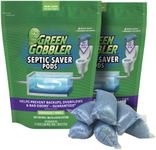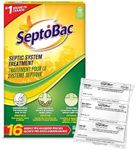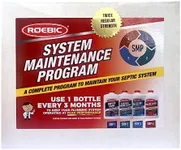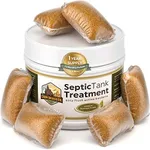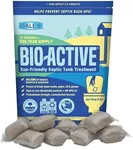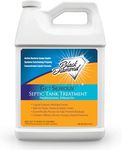Buying Guide for the Best Septic Tank Treatments
Choosing the right septic tank treatment is important for maintaining a healthy and efficient septic system. The right product can help break down waste, prevent clogs, and reduce odors, ultimately extending the life of your septic system. When shopping for a septic tank treatment, it's important to understand the different types of treatments available, how often they need to be used, and what ingredients they contain. By considering your household size, usage habits, and any specific issues you may be experiencing, you can select a treatment that best fits your needs and keeps your septic system running smoothly.Type of TreatmentSeptic tank treatments generally come in three main types: biological, chemical, and enzymatic. Biological treatments use natural bacteria and enzymes to break down waste, making them safe for the environment and effective for regular maintenance. Chemical treatments use strong substances to kill bacteria and dissolve clogs, but they can sometimes harm your septic system or the environment if overused. Enzymatic treatments focus on breaking down specific types of waste, like fats or proteins. For most households, biological treatments are recommended for ongoing maintenance, while chemical or enzymatic options might be used for specific problems. Consider your system's needs and any environmental concerns when choosing the type.
Form of TreatmentSeptic tank treatments are available in various forms, including powders, liquids, tablets, and pods. Powders and liquids are easy to measure and pour, making them suitable for regular use. Tablets and pods offer convenience, as they are pre-measured and can be simply dropped into the toilet. The choice of form often comes down to personal preference and convenience. If you prefer a mess-free and simple application, tablets or pods might be best. If you want more control over the dosage, powders or liquids could be a better fit.
Frequency of ApplicationThe frequency with which you need to apply a septic tank treatment can vary from monthly to quarterly or even annually, depending on the product and your household's usage. More frequent treatments can be beneficial for larger households or systems that see heavy use, while less frequent applications may suffice for smaller households. Always follow the manufacturer's recommendations, but also consider your own usage patterns. If you have a busy household, a monthly treatment may help maintain optimal performance.
Ingredients and SafetyThe ingredients in septic tank treatments can range from natural bacteria and enzymes to harsh chemicals. Natural ingredients are generally safer for your septic system, plumbing, and the environment. Chemical ingredients may be effective for tough clogs or odors but can sometimes disrupt the natural balance of bacteria in your tank. If you have concerns about environmental impact or want to avoid damaging your system, look for treatments with natural, biodegradable ingredients. Always check the label for safety information, especially if you have pets or children in the home.
Effectiveness for Specific IssuesSome septic tank treatments are designed to address specific problems, such as odor control, grease buildup, or slow drainage. If you are experiencing a particular issue, look for a treatment that targets that problem. For example, if odors are a concern, choose a product formulated for odor elimination. If you have frequent clogs, a treatment that breaks down fats and solids may be more effective. Matching the treatment to your specific needs will help you get the best results.


